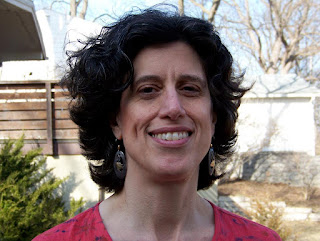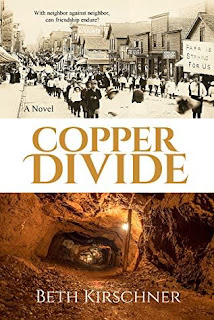Beth Kirschner is the author of the new historical novel Copper Divide, which takes place in Michigan in 1913. She also works as a software engineer.
Q: What inspired you to write Copper Divide, and how did you
create your characters Hannah and Nelma?
A: I was inspired to use the setting of Michigan’s Keweenaw Peninsula in a
story. The area is defined by diverse landscape, challenging winter weather,
and characters as unique as the place itself. In college I took a class on the
local history, and I think that was the original catalyst for the story.
The Italian Hall tragedy still generates strong emotions over 100 years later,
and I wanted to create characters to explore the different perspectives about
what actually happened.
I wanted characters as diverse as the actual demographics of
the time, so a Jewish shopkeeper’s daughter, a Finnish labor rights activist,
and an outsider brought in to break the strike covered a lot of intersecting
plot lines.
Q: What did you see as the right blend of fiction and history as you wrote the
novel?
A: I wanted to create characters that witnessed that historical moment, to
imagine how it impacted their lives and their thoughts. I used history as the
framework for what influenced their day-to-day lives, but I also wanted to
explore the characters independent of those external events.
There were some actual historical characters, such as Charles Moyer, who were
in the first draft of the story, that I later removed. Instead, I blended
actual historical events with fictional, composite characters, to create, I
hope, a more compelling perspective.
I wanted to use history as a foil to explore how people react during times of
social unrest. A lot of the themes in the story, such as attitudes towards
immigrants, corporate rights versus workers' rights, and the inability of
people on different sides of a conflict to see the humanity in each other, are
just as true today as they were then.
Q: How did you research the events of 1913, and did you learn anything that
especially surprised you?
A: The research for the story was a project in and of itself. I looked to
historical libraries for newspaper articles, maps, diaries, and photos, as well
as scholarly books. Two of the best books on the subject were Rebels on the
Range (Arthur Thurner) and Cradle to Grave (Larry Lankton).
I also needed to learn about the cultural customs of that
time and place, including fashion, entertainment, transportation, and food.
There were a lot of surprising discoveries along the way, including the details
of living in a highly paternalistic society where everything revolved around
the copper mines. The workers’ housing and land for the churches and synagogue
were all provided by the copper mine companies.
The more interesting discoveries were the smaller details of daily life, such
as how to roast coffee beans, how to make bark bread, and the novelty of
electricity that caused an entertainment pavilion to be named “Electric Park.”
Q: What do you hope readers take away from the book?
A: I hope readers are able to escape to another place and time, and immerse
themselves in the story, since that’s what I find most satisfying from books
that I enjoy. There’s also a lot of interesting history to be learned.
Most of all, though, I hope readers can reflect on the
complexity of one’s character that makes it difficult to label a person as good
or bad, right or wrong.
Q: What are you working on now?
A: I love settings in a story that are as complex and varied as the characters
themselves.
I’ve spent a lot of time in the American Southwest, and it’s a place with a rich past but also with many interesting possible futures.
There’s the impact of climate change, fires, water shortages, and energy needs. There’s the beauty of the arid high desert, red rock mesas and the unique individuals living in cities, pueblos, ranches, and small towns.
I’m still getting to know the characters that I’d like to create in my next novel, but they will likely live in northern Arizona or southern Utah, sometime in the near future.
--Interview with Deborah Kalb


No comments:
Post a Comment